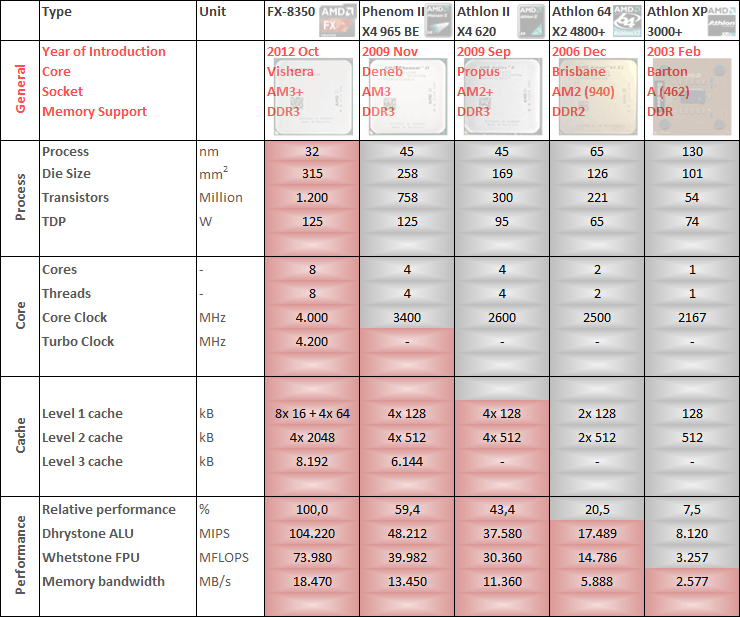Er heeft een gebruiker (ShockG) op een forum wat info gegeven over Zen. Het klinkt goed, maar let op de bron valt niet te controleren. Het topic is niet meer bereikbaar, maar er staat nog wat in het archief van Google.
Hij zei de volgende interessante dingen:
https://webcache.googleus...cd=2&hl=en&ct=clnk&gl=eng
Hij zei de volgende interessante dingen:
https://webcache.googleus...cd=2&hl=en&ct=clnk&gl=eng
Apologies if there's another thread about AMD's upcoming CPU architecture and of course desktop CPUs, if there is, delete or perhaps merge this info.
This is the current state of the retail CPUs, which have been improving by the month.
- There are some errata issues present in the current testing samples, similar in a way to the TLB bug of the Phenom. The workaround right now is done via the BIOS. The workaround however, strips around 30 ~ 40% of the CPU performance.
- The CPUs are well behind schedule and every day there's real progress and bug fixing being done. Unlike with INTEL's E0 CPUs which make it to the wild that are almost completely final silicon. AMD's samples will continue to get bug fixes right up until retail spec sampling to partners.
- In August Clock speeds were 3.8GHz, right now 4.2GHz overclocking is possible, with LN2 5GHz is doable. Again this will change of course, but it is just the current silicon that is behaving like this.
- AM4/ZEN uses an SOC design, that means even CMOS/BIOS configuration is on package (not necessarily on silicon, I can't confirm this) so it is possible to clear the "BIOS" and still have old value applied 30 minutes later. How this will be addressed remains to be seen. Perhaps it won't be the same scenario for final silicon
- Operating voltages (nominal) are 1.3v and all the way up to 1.5v should be fine it seems for AIO cooling. Frequency scaling isn't a strong point but again that may have everything to do with the process at this point rather than an inherent design limitation.
- Performance is particularly strong at this point vs. INTEL's latest offerings. Single thread performance is matching Haswell-E and of course multi-threading performance as well. Tests that are memory bandwidth dependent may go to the INTEL platform simply as a result of having more memory channels, but I can't confirm that right now and have no info on that. The important thing here is that the 16Thread/8-Core CPU is minimum 5960X performance if not better actually. (Based on Cinebench R15) with the error fix disabled.
- Can't speak to how well the IMC is working as current samples are locked to low DRAM frequencies (2133MHz and lower) and of course this has an impact on performance.
- As stated in the beginning, every week is progress and AMD is working at an unprecedented rate to get these ready by March.
- You're unlikely to see any high end boards for the CPUs prior to launch or at launch, simply because no vendors can commit to too much right now as plenty is changing at a rapid rate.
Everyday I know less and less about more and more.
https://webcache.googleus...d=3&hl=eng&ct=clnk&gl=engNo idea on any pricing yet, but from board vendor side, Highest SKU is Less than $700USD.
March is the target time for the CPUs. I don't suspect 1st generation boards will be all that great though.
We finally have native/chipset NVme, PCI-E 3.0 + USB 3.1 with a number of lanes for each.
This one is shaping up well, and a definite contender for INTEL and AMD users alike.
That Cinebench R15 MT score
6900K @ 5.1GHz 2,100~
8C/16T ZEN @ 5.1GHz 2,000 (workaround disabled)
[...]
I'm excited because of the potential I see even this early. AMD can't help but get in their own way, but things are still looking up. They can only be better with 2nd gen Zen.
Anyway here goes
==============================================
* All overclocking is done via Overdrive, you can't change any performance features at all in the BIOS (on to that next) at all.
* BIOS or UEFI is actually built into the CPU, so only AMD can update the "BIOS" or microcode. All overclocking must take place within the Operating system
* Right now it takes up to 30 minutes to clear the BIOS. If you remove the CPU and place it on another motherboard, it'll have the same settings applied as on the previous board. So debugging is a nightmare
* 6850K SKU (May not be final designation) is wait for it.... $300 roughly. That's 8 Cores and 16 Threads
* AMD's Hyper Threading is called SMU and it is damn good. The same efficiency as Intel's HT.
* Performance is really good, be it SuperPi, Cinebench, 3DMark etc, it's FPU performance is incredibly good and easily matching that of what Intel offers.
* Current performance is staggering even though it is limited to 2133MHz (as mentioned before) and NorthBridge Frequency is limited to 2400MHz
* There will be a nigher SKU than the 6850K, but it is a higher bin so it will certainly overclock better than 6850K and that may carry a premium price, but unlikely to be double.
* There's plenty of excitement from all board vendors about the platform, so we will see how it all pans out. (Especially with the hot mess that INTEL has in store for us H2 2017, that we can leave to another thread)
* For Gaming, the CPU is neck and neck with INTEL, even at low res where CPU bound.
================================================== ============
AMD is coming for em, NVIDIA and INTEL. 2017 is going to be a real kicker of a year as AMD will be able to provide premium performance at under $1,000 for the entire platform (CPU, board and VGA) whereas the equivalent from INTEL is about $1,000 just for the CPU.
If there's any questions I'll answer what I'm allowed to.
:strip_icc():strip_exif()/u/357407/crop5614c78b48976_cropped.jpeg?f=community)
:strip_icc():strip_exif()/u/240280/5.jpg?f=community)
:strip_icc():strip_exif()/u/454512/crop56da14dba10bd_cropped.jpeg?f=community)



:strip_exif()/u/327460/cowboy.gif?f=community)
:strip_icc():strip_exif()/u/83337/countess6-nice.jpg?f=community)
:strip_icc():strip_exif()/u/323108/lambo.jpg?f=community)
/u/200133/artemis_square_e_60-60.png?f=community)
:strip_icc():strip_exif()/u/291146/crop5d31533862205_cropped.jpeg?f=community)


:strip_exif()/u/233284/crop573f69b75d616.gif?f=community)

/u/139379/format-c.png?f=community)
:strip_icc():strip_exif()/u/124220/Poes%252057x57.jpg?f=community)
/u/331213/crop56ef13408ff38_cropped.png?f=community)
/u/400/defember100.png?f=community)
:strip_icc():strip_exif()/u/544669/someone%2520is%2520wrong%2520on%2520the%2520internet60.jpg?f=community)
:strip_icc():strip_exif()/u/139806/monitored.jpg?f=community)
:strip_icc():strip_exif()/u/28340/crop5cef80e9d69f8_cropped.jpeg?f=community)
